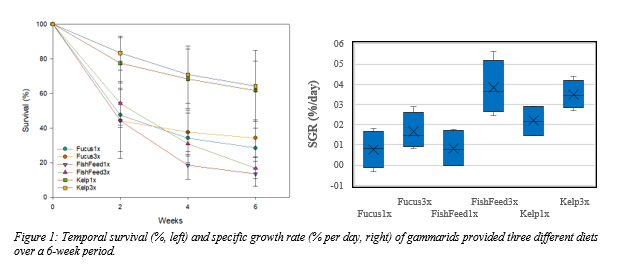THE IMPACT OF DIET AND FEEDING FREQUENCY ON THE PERFORMANCE OF JUVENILE Gammarus IN INTENSIVE CULTURE SYSTEMS
Introduction
To meet the rising demand for sustainable feed ingredients in aquaculture, new, alternative sources must be explored. Gammarids represent a promising low-trophic option due to their favorable protein and fatty acid profiles, as well as their role as a natural food source for many fish species (Harlıoğlu and Farhadi, 2018). They are also well-suited for high density cultivation and can be reared on a variety of marine and terrestrial side streams (Ribes-Navarro et al., 2022, Alberts-Hubatsch et al., 2019). For efficient production in intensive systems, it is crucial to understand how different diets and feeding strategies influence their growth and survival to be able to optimize production.
Materials and methods
In this study, juvenile marine Gammarus were fed over a six-week period with one of three diets: fresh Fucus sp., commercial fish feed, or dried sugar kelp Saccharina latissima. Each diet was provided at two feeding frequencies, with feed supplied ad libitum once and three times weekly. The experiment was conducted in quadruplicates for each treatment, with 30 individuals assigned randomly to each beaker. The experimental units, filled with 700 mL of seawater (35 ppt, 99% DO, pH 8.1), were kept at a constant temperature of 12.3 °C and a 12L:12D light regime. Approx. 50% of the seawater was changed three times a week for all beakers.
Gammarids were sampled at the beginning and at the end of the experiment to obtain data on survival, total lengths, as well as the corresponding individual dry weight (DW) and carbon and nitrogen (CN) samples. Moreover, data on length measurements and survival was collected bi-weekly.
Results and discussion
Preliminary results from the feeding experiment show that gammarids fed with sugar kelp had the highest survival rates across both feeding frequencies, and that the feeding interval had no significant effect on the survival of Gammarus across the dietary treatments. Gammarids fed with fish feed three times per week exhibited a significantly higher specific growth rate (SGR) compared to those in the Fucus treatment at the same feeding frequency. The juveniles in the fish feed treatment provided three times a week also had significantly higher SGR than the ones who were fed once a week. Otherwise, no significant differences in SGR were observed between the other diets or feeding frequencies.
Conclusion
Overall, the diet had a stronger impact on the survival of the gammarids than the feeding frequency. A higher feeding frequency promoted higher growth, although not significant, and a further increase in feeding frequency (e.g. daily) could be explored. Fish feed fed three times a week resulted in a high growth rate, but overall poor survival. Thus, it can be concluded that the dried sugar kelp had the best effect on both growth and survival among the tested diets.
References
ALBERTS-HUBATSCH, H., SLATER, M. J. & BEERMANN, J. 2019. Effect of diet on growth, survival and fatty acid profile of marine amphipods: implications for utilisation as a feed ingredient for sustainable aquaculture. Aquaculture Environment Interactions, 11, 481-491. 10.3354/aei00329
HARLıOĞLU, M. & FARHADI, A. 2018. Importance of Gammarus in aquaculture. Aquaculture International, 26. 10.1007/s10499-018-0287-6
RIBES-NAVARRO, A., ALBERTS-HUBATSCH, H., MONROIG, Ó., HONTORIA, F. & NAVARRO, J. C. 2022. Effects of diet and temperature on the fatty acid composition of the gammarid Gammarus locusta fed alternative terrestrial feeds. Frontiers in Marine Science, Volume 9 - 2022. 10.3389/fmars.2022.931991
